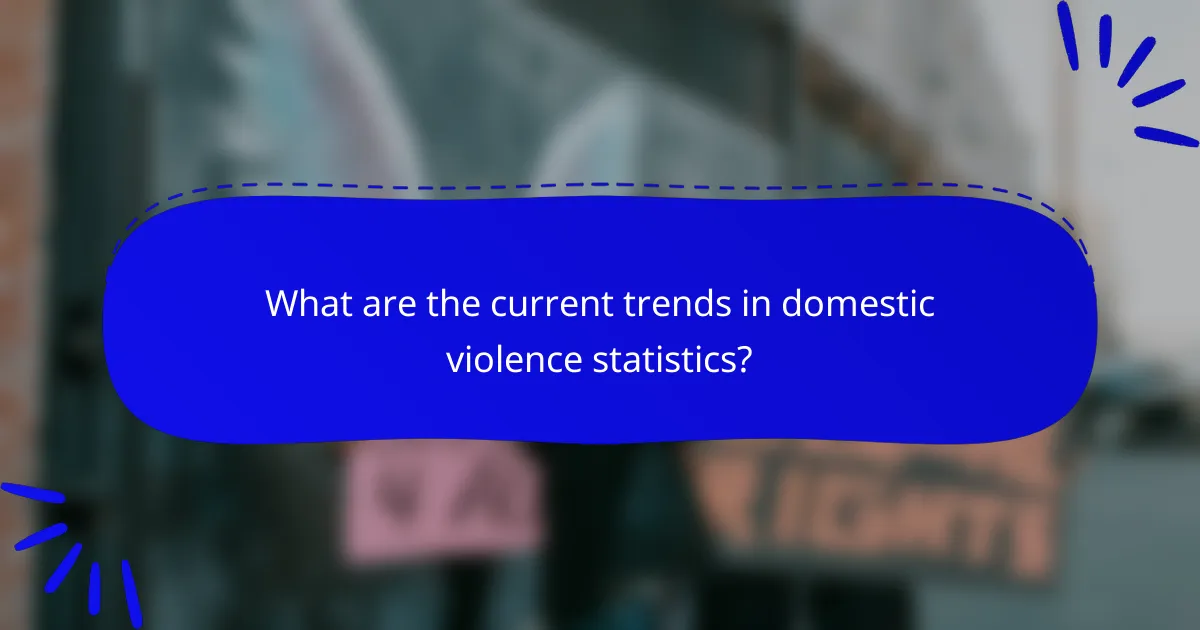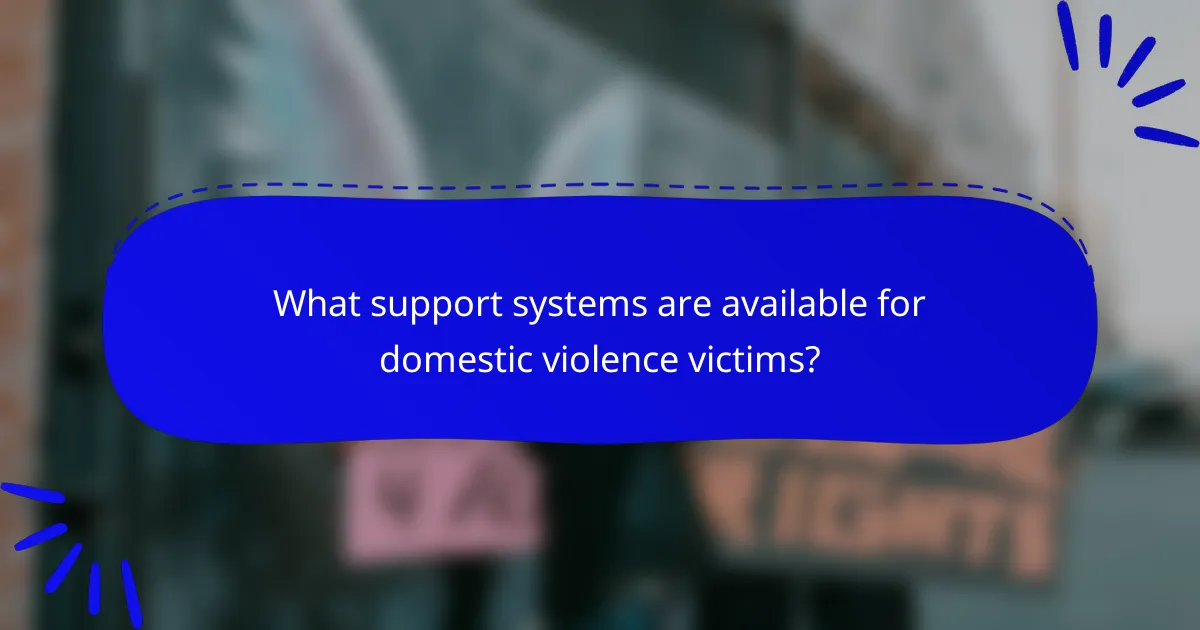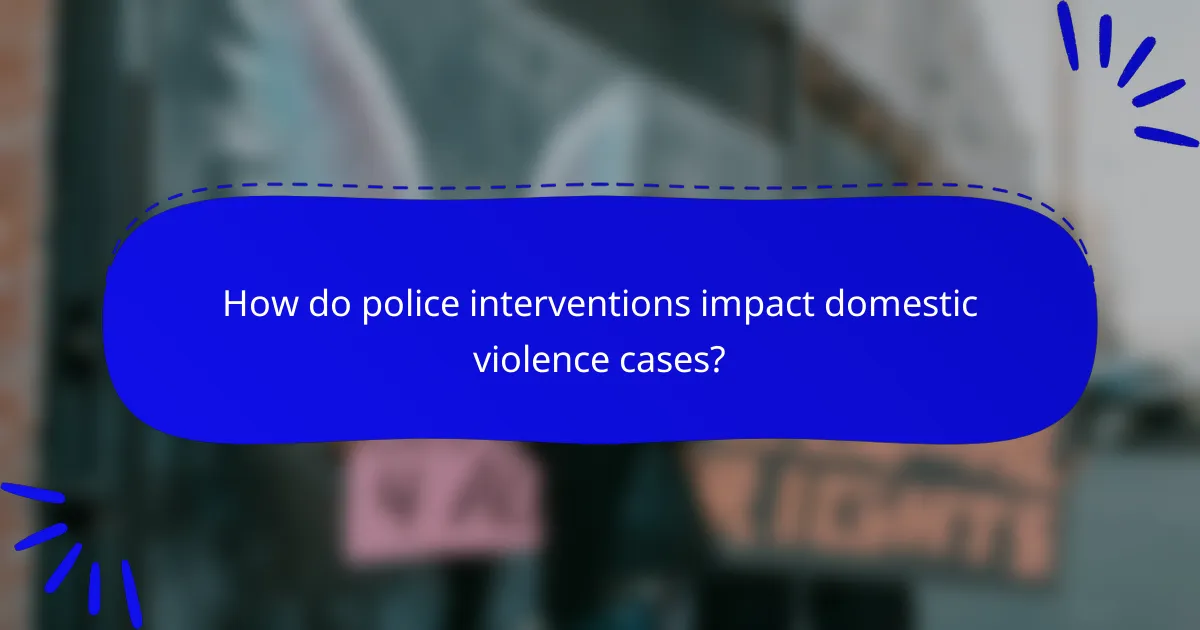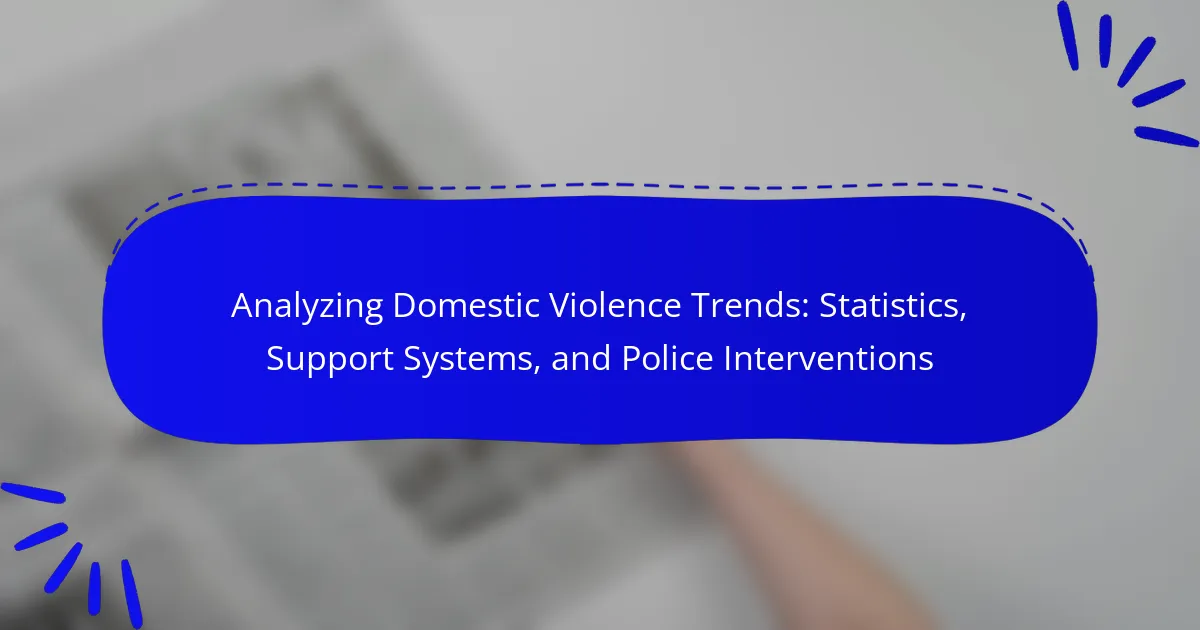
What are the current trends in domestic violence statistics?
Current trends in domestic violence statistics indicate an increase in reported incidents. According to the National Coalition Against Domestic Violence, 1 in 4 women and 1 in 9 men experience severe intimate partner physical violence. The COVID-19 pandemic has exacerbated these issues, leading to a surge in calls to domestic violence hotlines. In 2020, many regions reported a 20-30% increase in calls for help. Furthermore, the economic strains during the pandemic contributed to higher instances of domestic violence. Recent studies show that marginalized communities are disproportionately affected. Data from the Bureau of Justice Statistics reveals that approximately 15 million children are exposed to domestic violence annually. These statistics highlight the urgent need for effective support systems and interventions.
How do domestic violence statistics vary by region?
Domestic violence statistics vary significantly by region. In North America, approximately 1 in 4 women experience severe intimate partner physical violence. In Europe, reported rates are generally lower, averaging around 1 in 10 women. In Asia, the statistics can be higher in certain countries, with some reporting rates as high as 37%. Africa also shows high prevalence, with studies indicating that up to 36% of women face violence from intimate partners. The differences in statistics often reflect cultural attitudes, legal frameworks, and reporting practices. For instance, regions with strong support systems may report lower statistics due to effective intervention programs. Conversely, areas with stigma around reporting may show inflated numbers due to underreporting.
What factors contribute to regional differences in domestic violence rates?
Regional differences in domestic violence rates are influenced by various factors. Socioeconomic status significantly impacts these rates. Areas with higher poverty levels often report increased domestic violence incidents. Cultural attitudes towards gender roles also play a crucial role. Regions with traditional views may see higher rates of tolerance for violence. Access to support services affects reporting and help-seeking behavior. Areas with fewer resources may underreport incidents. Law enforcement practices vary by region, influencing how cases are handled. Regions with proactive policing may see lower rates due to effective intervention. Additionally, education and awareness programs can reduce domestic violence by promoting healthy relationships.
How do demographics influence domestic violence statistics?
Demographics significantly influence domestic violence statistics. Factors such as age, gender, race, and socioeconomic status shape the prevalence and reporting of domestic violence. For instance, younger individuals, particularly women aged 18-24, report higher rates of intimate partner violence. Gender plays a critical role, as women are more likely to be victims, while men are often perpetrators. Racial disparities also exist; studies show higher rates of domestic violence in certain minority communities. Socioeconomic factors, such as poverty and unemployment, correlate with increased domestic violence incidents. According to the National Intimate Partner and [censured] Violence Survey, nearly 1 in 3 women and 1 in 4 men experience some form of physical violence by an intimate partner during their lifetime. Understanding these demographics helps in tailoring prevention and intervention strategies effectively.
What are the most common forms of domestic violence reported?
The most common forms of domestic violence reported include physical abuse, emotional abuse, and economic abuse. Physical abuse involves intentional harm through actions like hitting or slapping. Emotional abuse includes manipulation, threats, and psychological harm. Economic abuse restricts a partner’s access to financial resources. According to the National Coalition Against Domestic Violence, nearly 20 people per minute experience physical abuse by an intimate partner in the U.S. This statistic highlights the prevalence of these forms of domestic violence.
How do psychological, physical, and emotional abuse manifest in statistics?
Psychological, physical, and emotional abuse manifest in statistics through various measurable indicators. According to the National Coalition Against Domestic Violence, approximately 1 in 4 women and 1 in 9 men experience severe intimate partner physical violence. Emotional abuse is reported by 48.4% of women and 48.8% of men, indicating its prevalence. The World Health Organization states that 35% of women worldwide have experienced either physical or [censured] intimate partner violence. Statistics from the U.S. Department of Justice show that nearly 20 people per minute are physically abused by an intimate partner. Psychological abuse, while harder to quantify, is often reported alongside physical violence, with studies indicating that 90% of domestic violence cases involve some form of psychological abuse. These statistics highlight the pervasive nature of these forms of abuse across demographics.
What percentage of domestic violence cases involve repeat incidents?
Approximately 70% of domestic violence cases involve repeat incidents. Studies indicate that many victims experience multiple occurrences of violence. The U.S. Department of Justice reports that repeat victimization is a significant issue in domestic violence cases. This statistic highlights the cyclical nature of domestic violence and the challenges in addressing it effectively.

What support systems are available for domestic violence victims?
Support systems available for domestic violence victims include shelters, hotlines, and counseling services. Shelters provide safe housing and resources for victims in crisis. Hotlines offer immediate support and guidance 24/7. Counseling services help victims process trauma and rebuild their lives. Legal assistance is also available to navigate protective orders and court proceedings. Community organizations often provide outreach and support groups. These resources aim to empower victims and facilitate recovery. According to the National Coalition Against Domestic Violence, approximately 1 in 4 women and 1 in 9 men experience severe intimate partner physical violence.
How do shelters and hotlines aid victims of domestic violence?
Shelters and hotlines provide critical support to victims of domestic violence. Shelters offer safe housing, protection from abusers, and access to essential resources. They often provide counseling, legal assistance, and support groups to help victims rebuild their lives. Hotlines offer immediate, confidential support and guidance. Victims can receive emotional support and information about available resources. According to the National Domestic Violence Hotline, over 70% of callers report feeling safer after contacting the hotline. This demonstrates the effectiveness of these support systems in aiding victims.
What services do shelters provide to support victims?
Shelters provide various services to support victims of domestic violence. These services include emergency housing for immediate safety. Shelters also offer counseling and support groups to help victims process their experiences. Legal assistance is often available to help navigate restraining orders and custody issues. Additionally, shelters provide access to resources such as job training and financial literacy programs. Many shelters have children’s programs to support young victims. They also offer meals and basic necessities to ensure victims’ immediate needs are met. According to the National Network to End Domestic Violence, over 70% of shelters provide legal services and advocacy. These comprehensive services aim to empower victims and facilitate their recovery.
How effective are hotlines in connecting victims to resources?
Hotlines are highly effective in connecting victims to resources. They provide immediate access to support services and information. Studies indicate that 70% of hotline users report feeling more empowered after the call. Additionally, hotlines often serve as a critical first step in the recovery process. They facilitate referrals to shelters, counseling, and legal assistance. Research shows that victims who use hotlines are more likely to seek further help. For example, a study by the National Domestic Violence Hotline found that 60% of callers accessed additional resources after their initial contact. This demonstrates the vital role hotlines play in bridging the gap between victims and necessary support systems.
What role do community organizations play in supporting victims?
Community organizations play a crucial role in supporting victims of domestic violence. They provide essential resources such as shelter, counseling, and legal assistance. Many organizations offer crisis intervention services that help victims immediately after an incident. They also facilitate support groups that foster community and healing among survivors. Research shows that access to these services can significantly improve a victim’s recovery and safety. According to the National Network to End Domestic Violence, community organizations are vital in connecting victims with necessary services. Their efforts contribute to raising awareness and educating the public about domestic violence issues. Overall, community organizations are fundamental in creating a supportive environment for victims.
How do advocacy groups contribute to awareness and prevention?
Advocacy groups contribute to awareness and prevention of domestic violence through education and outreach initiatives. They provide information on the signs of abuse and available resources. Many advocacy groups host workshops and seminars to inform communities. They also create campaigns that highlight the prevalence of domestic violence. For example, the National Domestic Violence Hotline reported receiving over 300,000 calls in a single year. This indicates a significant need for awareness. Advocacy groups often collaborate with local law enforcement and healthcare providers. This collaboration helps to ensure that victims receive comprehensive support. By raising awareness, these groups empower individuals to seek help and report abuse.
What partnerships exist between organizations and law enforcement?
Partnerships between organizations and law enforcement include collaborations with non-profits, community groups, and governmental agencies. These partnerships aim to address domestic violence through coordinated responses. For instance, organizations like the National Domestic Violence Hotline work with law enforcement to provide resources and support for victims. Additionally, local shelters often collaborate with police departments to ensure safe housing for those escaping violence. Programs such as law enforcement-assisted diversion (LEAD) also exist, where police work with social service organizations to provide alternatives to arrest. These partnerships enhance community safety and improve victim support services.

How do police interventions impact domestic violence cases?
Police interventions significantly impact domestic violence cases by increasing the likelihood of arrest and prosecution of offenders. Research indicates that when police respond to domestic violence calls, arrests are made in approximately 50% of cases. This intervention can deter future violence, as offenders may face legal consequences. Studies show that jurisdictions with mandatory arrest policies see a reduction in repeat offenses. Additionally, police involvement often connects victims to support services, enhancing their safety and access to resources. A 2019 report by the National Institute of Justice found that effective police responses lead to improved victim outcomes and lower rates of re-victimization. Thus, police interventions play a crucial role in addressing and reducing domestic violence incidents.
What are the common police responses to domestic violence incidents?
Common police responses to domestic violence incidents include immediate intervention and assessment of the situation. Officers typically separate the involved parties to ensure safety. They assess any injuries and provide medical assistance if necessary. Police may arrest the aggressor if there is probable cause. Officers often document the incident through reports and photographs. They may also provide information on local resources for victims. Additionally, police might file charges based on evidence collected. These responses aim to protect victims and hold offenders accountable.
How do police protocols differ across jurisdictions?
Police protocols differ across jurisdictions based on local laws, departmental policies, and community needs. Each jurisdiction has its own legal framework that dictates how police should respond to incidents. For instance, some areas may prioritize de-escalation techniques while others may emphasize arrest. Training programs also vary, leading to differences in how officers handle domestic violence cases. In addition, funding levels can influence the availability of resources for victim support. Research shows that jurisdictions with specialized domestic violence units often achieve better outcomes. The National Institute of Justice highlights that tailored approaches can lead to increased reporting and improved victim safety.
What challenges do police face in responding to domestic violence?
Police face several challenges in responding to domestic violence incidents. One significant challenge is the underreporting of such cases. Many victims fear retaliation or do not trust law enforcement. Another challenge is the complexity of domestic violence situations. Officers must assess the dynamics between the individuals involved. They often encounter emotional volatility, which can escalate quickly. Additionally, police may lack adequate training specific to domestic violence. This can hinder their ability to effectively de-escalate situations. Resource limitations also pose a challenge. Many departments struggle with staffing and funding, impacting response times. Lastly, legal constraints can complicate interventions. Officers must navigate laws regarding arrest and evidence collection. These combined factors create a difficult environment for police when addressing domestic violence.
What are the outcomes of police interventions in domestic violence cases?
Police interventions in domestic violence cases can lead to several outcomes. Immediate outcomes include arrest of the perpetrator and provision of safety for the victim. Studies show that arrest can deter future violence in some cases. For instance, research by the National Institute of Justice indicates that mandatory arrest policies can reduce repeat offenses. However, the effectiveness varies by context and the relationship dynamics involved. Victims may also experience increased feelings of safety or, conversely, retaliation from the abuser. Long-term outcomes can include legal consequences for the perpetrator and access to support services for the victim. These interventions aim to break the cycle of violence and promote accountability.
How do police interventions affect victim safety and recidivism rates?
Police interventions can significantly enhance victim safety and reduce recidivism rates. When law enforcement responds promptly to domestic violence incidents, it often leads to immediate protection for victims. A study by the National Institute of Justice found that victims who received police intervention reported feeling safer and more supported.
Furthermore, effective police interventions can deter future offenses. Research indicates that when offenders are arrested, the likelihood of reoffending decreases. For example, a study published in the Journal of Interpersonal Violence showed that arresting domestic violence offenders led to a 30% reduction in repeat offenses.
In summary, police interventions play a crucial role in improving victim safety and lowering recidivism rates. The evidence supports the effectiveness of these interventions in creating safer environments for victims and deterring future violence.
What training do police officers receive regarding domestic violence?
Police officers receive specialized training regarding domestic violence to effectively respond to incidents. This training covers recognizing signs of abuse, understanding the dynamics of domestic violence, and legal protocols. Officers learn about victim support resources and how to conduct interviews sensitively. Training also includes de-escalation techniques and safety planning for victims. Many police departments collaborate with domestic violence organizations for comprehensive training. This ensures officers are equipped with current best practices. Research indicates that well-trained officers are more effective in handling domestic violence cases. Effective training can lead to improved victim outcomes and increased reporting of incidents.
What best practices can improve police effectiveness in domestic violence cases?
Best practices to improve police effectiveness in domestic violence cases include specialized training for officers. This training should focus on recognizing signs of abuse and understanding victim psychology. Implementing a coordinated response with local support services enhances communication and resources. Establishing clear protocols for evidence collection ensures thorough investigations. Using technology, such as body-worn cameras, can provide accountability and documentation of incidents. Engaging in community outreach fosters trust and encourages reporting. Regular reviews of case outcomes help identify areas for improvement. Research indicates that departments adopting these practices see higher rates of victim support and case resolution.
The main entity of this article is domestic violence, encompassing its trends, statistics, support systems, and police interventions. The article analyzes current statistics indicating a rise in domestic violence incidents, particularly during the COVID-19 pandemic, and highlights regional variations influenced by socioeconomic factors and cultural attitudes. It also examines the demographics affected by domestic violence, common forms of abuse reported, and the effectiveness of support systems such as shelters and hotlines. Additionally, the article discusses police interventions, their impact on victim safety and recidivism rates, and best practices for improving police effectiveness in handling domestic violence cases.
